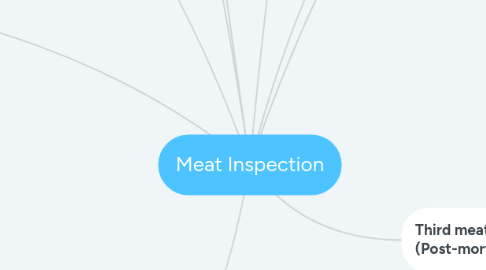
1. Activities of meat inspection
1.1. On arrival
1.2. Ante-mortem
1.3. Post-mortem
2. Regulation on livestock slaughtering
2.1. The Animal Ordinance, 1953
2.1.1. Section 51
2.1.2. Section 86 Subsection 2
2.2. Animal (Control of Slaughter) Rules, 2009
2.3. Meat Inspection Rules, 1985
3. Production operations of raw & fresh meat
3.1. Production at farm
3.2. Transport to abattoir (Meat inspection)
3.3. Holding - Lairage (Meat inspection)
3.4. Stunning, Slaughtering, Bleeding
3.5. Removal of skin/hair/feather
3.6. Evisceration
3.7. Washing (Meat inspection)
3.8. Cutting, labeling, stamping, packaging
3.9. Meat- Collected, distributed
3.10. To consumer
4. First meat inspection (On arrival)
4.1. Screen, observe for any abnormalities in behaviour, appearance and live/dead
4.2. Check Animal identification requirements, farm owner declarations on disease status and compliance use of vet drugs
5. Second meat inspection (Ante-mortem inspection)
5.1. Inspection of an animal just before slaughter
5.2. Purpose
5.2.1. To prevent diseased animals, unfit for human consumption from being slaughtered
5.2.2. To prevent unnecessary contamination of other animals
5.3. Procedure
5.3.1. Done on the day of slaughter
5.3.2. Animal sufficiently rested
5.3.3. Vet-in-charge must be present
5.3.4. Observe the animals from head to tail to limbs, on both sides
5.3.5. Observe the animals at rest and in motion
5.4. Judgement / disposition of inspected animals
5.4.1. Animal passed as healthy and fit for slaughter
5.4.2. Animal permitted for slaughter but under close supervision and may require detailed postmortem examination
5.4.2.1. Anaemia, diarrhoea, generalized skin lesions, jaundice, lameness, localized abscesses, wounds
5.4.3. Animal withheld from immediate slaughter / delayed slaughter
5.4.3.1. Excessive fatigue, excited animals, profuse diarrhea & fever, suspected treatment with illegal drug/excessive antibiotics
5.4.4. Animals for emergency slaughter
5.4.4.1. Injured or crippled, heat stress
5.4.5. Animals not permitted for slaughter
5.4.5.1. Not allowed for treatment, not allowed to pass into slaughter hall and not allowed to leave premise
6. Purpose
6.1. To prevent entry of diseased meat into the food chain
6.2. To ensure only apparently healthy & physiologically normal animals are slaughtered
7. Benefites
7.1. Control of animal diseases at farm level
7.2. Information regarding causes of contamination
8. Abattoir / Slaughtering facilities and operating requirement
8.1. Abattoir construction and layout
8.2. Sanitary facilities and control
8.3. Equiments
8.4. Hygiene operating requirements
8.5. Health & hygiene of workers
8.6. Operation & processing areas
9. Third meat inspection (Post-mortem inspection)
9.1. Inspection of the carcases & parts of the animals after slaughtered & dressed
9.2. Total evidence: observation, palpation, incision, smell, AMI & lab test results
9.3. Purpose
9.3.1. To remove diseased carcases and parts from food chain
9.3.2. To remove objectionable/aesthetically unacceptable meat
9.4. Procedure
9.4.1. Performed ASAP
9.4.2. Inspection: head > tongue > thoracic organ (lungs, heart, aorta) > abdominal organ (liver, oesophagus, spleen) > carcass > kidney
9.4.3. Determine: efficiency of bleeding, colour, odour, cleanliness & abnormalities-size, discharge, abscess
9.5. Judgements / disposition of the inspected carcases & parts
9.5.1. Carcases and parts passed as healthy & fit for consumption
9.5.2. Carcases and parts detained for further examination
9.5.3. Carcases and/or parts partially condemned
9.5.3.1. Caseous lymphadenitis, Brucellosis, Leptospirosis, Tuberculosis, Lungworm, Liver flukes
9.5.4. Carcases and parts totally condemned
9.5.4.1. Haemorrhagic septicaemia (Pasteurella multocida), Bovine malignant catarrhal fever, Meliodosis, Salmonellosis, Swine fever
9.5.4.2. Avian leucosis complex, Botulism, Erysipelas, Listeriosis, Ornithosis, Paratyphoid, Tuberculosis

